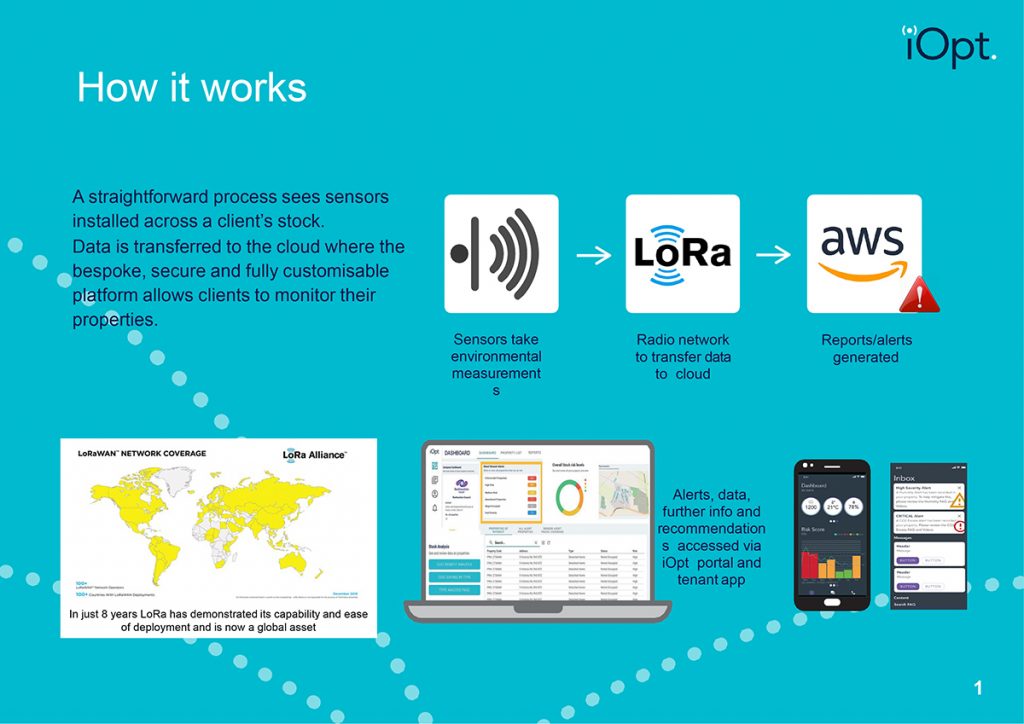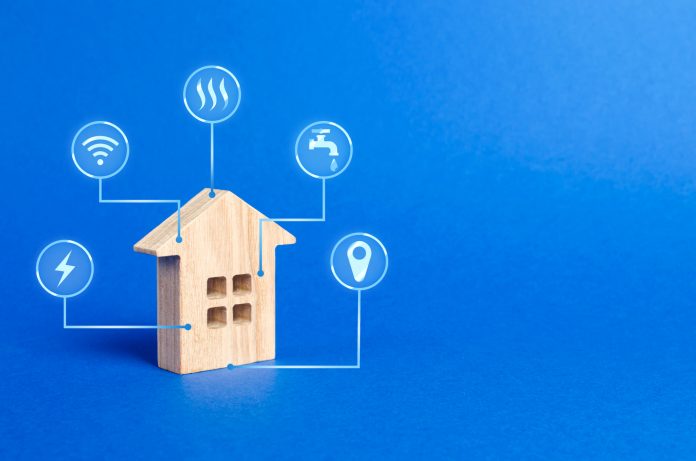Following a world-first agreement to install real-time monitors in thousands of social homes in Renfrewshire, iOpt founder and managing director Dane Ralston says it is now time for IoT adoption in housing to become the “new normal”
Established in 2016, UK-based iOpt uses data analytics, high-tech sensors and the latest IoT technology to allow owners and managers of large rental property portfolios, such as social housing landlords or build-to-rent investors, to remotely monitor the internal environment of their assets.
iOpt has 11 partners on its books with 300,000 properties under management by customers, including Renfrewshire Council, Leeds City Council and Places for People. Founder Dane Ralston has a 20-year track record in asset monitoring and predictive maintenance, having worked as a partnership builder with Goodrich Aerospace, Turkish Airlines and Aston Martin.
In just three months of lockdown, we witnessed three years of digital evolution, according to analyst McKinsey. That trend will accelerate as businesses and local and national governments increasingly turn to technological solutions to deal with the long-term health and economic consequences of Covid-19.
The nation was just easing out of lockdown in June when we announced winning a tender worth up to £1m to install real-time monitors in 2,400 social houses in Renfrewshire – a world-first that seeks to improve the lives of tenants while cutting property management and repair costs, supported with £150,000 from the Scottish Government’s CanDo Innovation Fund.
The new two-year project, which begins when lockdown restrictions are eased, see sensors fitted into selected empty properties being prepared for new tenants, who will also be supported with energy efficiency advice and guidance.
iOpt’s bespoke algorithms and machine learning techniques predict when and where issues such as mould growth will arise, allowing preventative intervention before repair costs or tenant health issues escalate. The technology vastly reduces the amount of property visits, cutting down on carbon emissions, while helping to identify and support vulnerable tenants who may be struggling with fuel poverty.
The Renfrewshire partnership was four years in the making, so our current groundwork was prepared long before the words Covid-19 or pandemic entered into our everyday language.
Like a number of our pilots across the UK, the focus was purely on energy efficiency and the questions we had to answer were: does real-time remote monitoring of housing let us evidence that energy efficiency projects result in benefits to the property condition and savings for tenants, can we quantify those saving and can we do it at scale?
The answer to all these is a resounding yes.
Our studies have shown maintenance savings of approximately £190 per year per property, a significant sum for local authorities juggling with budget priorities at a time of financial pressure.
The ROI of this technology goes well beyond direct cost-savings. Benefits include:
- Having real-time accurate visibility of asset conditions means the housing provider is in control, allowing for predictive and proactive maintenance interventions. It is well documented that proactive actions are typically five times less costly than reactive ones.
- Instant access to information means reduced administration, improved communication and fewer, more focused property visits.
- Having access to our data means that insurance companies and financial institutions will have more faith in housing providers, which can lead to reduced premiums.
- Working collaboratively, data can inform customers’ future home design and system and material procurement.
- And, critically, early warning of potential issues means healthier buildings and healthier tenants.
However, it is now vital we accelerate the adoption of this technology to tackle health and fuel poverty issues relating to poor housing exacerbated by Covid-19. Housing is now very much in the frontline of the war against the virus.

Remote monitoring and the ‘new normal’
The relationship between our work and combatting Covid-19 is two-fold. In the new norm of social isolation and lockdown, there are clear benefits for customers in remote monitoring rather than physical monitoring.
And real-time data monitoring of temperature, air quality and occupancy levels is an essential tool in curtailing the spread of the virus as more people spend more time indoors during the winter months.
There are a number of studies that prove a clear relationship between inefficient housing and the spread of Covid-19.
Preparing for a Challenging Winter, a report prepared by the Academy of Medical Sciences, says the right level of heating and ventilation in our homes reduces the risk of transmission. Coronavirus spreads more easily indoors and poor ventilation and overcrowding increases the density and build-up of infectious viral particles in a room.
According to the report, lower temperatures due to inadequate heating or poor insulation also reduce the body’s immunity to viruses.
Our systems are already picking up some early warning signs. We have seen CO2 emissions – the key indicator of poor ventilation that accelerates the spread of Covid-19 – increase by 40% as a result of more people staying at home during lockdown.
It has been long accepted that housing and public health go hand-in-hand.
The cost of poor housing to the NHS is estimated to be at least £2.5bn a year. To put that in context, that’s the same annual cost to the health service as treating smoking-related illness.
The most significant health gains can be achieved through prevention by using data to understand how we can best improve the quality of life for tenants.
Information is critical
The information we gather is critical in not just dealing with the current issues but also in preventing future problems. It can also be used to inform asset owners as to what aspects of their properties are the best performing, such as the most efficient types of boilers or what building types may need to get upgraded first with insulation.
As an example, working with Home Group and BRE, we are looking at a batch of 50 homes, with five property types, to examine which are the most efficient. This, in turn, could be extended to street and ultimately city levels.
All businesses need to be agile and adaptable to the needs of their customers. We worked with Leeds City Council on improving tenant experience and engagement by developing an app for tenants that works in conjunction with the full remote property monitoring platform.
The app keeps tenants updated on their property environment and prompts them to change their practices if required through educational info.
Last year, we were one of five companies chosen from 111 in a global competition to support the digitalisation of Places for People to help them drive team efficiencies, so asset managers can make fewer but more focused face-to-face tenant visits.
Looking to the future
As for the future, our own business was founded in 2016 so it is still relatively new. But we see a growing appetite for an IoT solution that delivers cost savings and is aligned with goals on health, the environment, energy efficiency and the smart cities revolution.
This market extends well beyond the UK. While there are 9m homes in the UK social and private sector, there are 40m in the US. In the Netherlands, 70% of housing is social, while in Singapore 78% of the population lives in publicly governed and developed homes.
The problems that we face are truly global and thrown into sharp relief by Covid-19. Poor environmental conditions cost money and cause health issues; hot dry countries with poor aircon see viruses spread due to low humidity; tenants in wet, mild countries are more prone to respiratory problems.
Our next round of investment will give us the ability to tackle that market, with a focus on recruiting more talent and refining our technology.
We have a scalable and sustainable business model and an IoT-driven solution that tackles a worldwide problem – a solution that improves the lives of people and protects valuable housing assets. The hard work and evaluation have been done and now it is time for IoT and energy efficiency adoption to be the new normal.
If there is one thing that we have learned from the current crisis, it is that this technology is no longer a “nice to have” but an essential part of an integrated approach to public health. It is time we all work collaboratively in the IoT space to accelerate what is already a proven success and seize this opportunity to build a fairer and healthier society.
Dane Ralston
Founder and managing director
iOpt

















